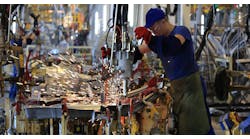Significant changes in overall supply management strategy and practice are already happening at progressive corporations. The changes are leading to positive financial impacts above and beyond what can be achieved through a primary focus on piece-price reduction.
Going forward, this column will share examples of such firms as I hear of them. Confirmation of these impacts should provide corporations on the fence on this issue that the benefits are real.
This week, I’m highlighting a company in both the commercial and consumer products market that is a major player in their industry, their products respected both for their function and high quality. Their vice president of supply chain management, whom I’ve had a professional relationship with for many years, agreed to share “secret-sauce” information to help others, but on the condition of anonymity.
Below, I’d like to share a blurb from their documented supply management strategy—which is shared with all suppliers—that will give you a window into their approach.
The top factor listed in their strategy is titled “Leveraging Time.” To that end, they have a goal to:
“… select and develop suppliers that compress their internal manufacturing cycle time to the point that they can produce and deliver parts within our customer lead time. To the extent that this is possible, we eliminate the cost of carrying inventory both in-house and at the supplier. We eliminate the cost of obsolescence and improve our responsiveness as we are not tethered with legacy considerations. Time compression drives out cost as it helps to eliminate the non-value-added work and overhead associated with wait time.”
Whoa. How many companies place a statement like this at the top of their supply management’s strategic plan? Not many, in my experience. And why is it important? Because the company has products with very seasonal and variable demand—which brings difficulty in making accurate forecasts and a very short time to react to demand that varies from forecast. This scenario should sound familiar with OEMs selling to consumers.
I won’t get into detail of other areas of strategic emphasis as I have above, but will comment on a few of them.
In additional to the typical supplier performance metrics—price, quality and delivery—the company expects their buyers to understand supplier operational metrics. For instance, suppliers are evaluated on supplier inventory turns and true lead times; i.e., those along the critical path. In fact, to verify this, the company encourages buyers to regularly visit suppliers, not expecting supply management personnel to manage their suppliers sitting behind a desk. Why do they do this? Because inventory turns and true lead time are primary metrics of cost and provide the basis for the working with their suppliers on operational improvement.
In this industry, many competitors have sourced a large percentage of their spend with overseas, low-wage countries. And according to my contact, supply management at this company also was under pressure to do so, and they did. However, they never went full bore into this, and today less than 10% is sourced offshore. In fact, I was told that included in their sourcing vision is “no water!”—referring to overseas transportation. This type of policy is to be expected for a company placing a high value on supplier order fulfillment flexibility and active collaboration between buyers and the suppliers they are responsible for.
How are these strategies and processes working? Although they would not share details on financial impact, another measure of success is reflected in how suppliers regard them. The company does an annual survey of suppliers to gain feedback on their performance. The most recent survey results included the following statistics:
- About 85% of the company’s suppliers feel they “talk straight” as well as “demonstrate respect.” I find it interesting that these two topics are even included in the survey, and suppliers rate this customer so highly in each.
- Almost 80% of their suppliers feel they “extend trust” and “keep commitments.” This implies that they feel the customer is not the type of company that will come in and request lower prices than those agreed upon in their current contract (an all-too-common practice today among Original Equipment Manufacturers).
- About 70% of suppliers feel the company “shows loyalty” and “makes things right.” This is reflected in the company’s extremely low supplier turnover, which reflects both customer and supplier satisfaction with the business relationship.
I wonder how many corporate supply management departments would think to measure supplier feedback in areas such as the ones above (there are more that I haven’t shared), and if so, would get such impressive results.
And I’ll add a point. It’s not that this company isn’t concerned with piece prices. They are. But the term is not mentioned once in their supply management strategic plan. Rather supplier cost reduction is the focus, and their approach is to collaborate with suppliers to reduce costs.
Let me know if you feel your company has adopted progressive supply management practices that positively add to the bottom line above-and-beyond piece price. I am always looking for exemplary companies to write about.
Paul Ericksen’s book is Better Business: Breaking Down the Walls of the Purchasing Silo. Ericksen has 40 years of experience in industry, primarily in supply management at two large original equipment manufacturers.




